FD Senior High History
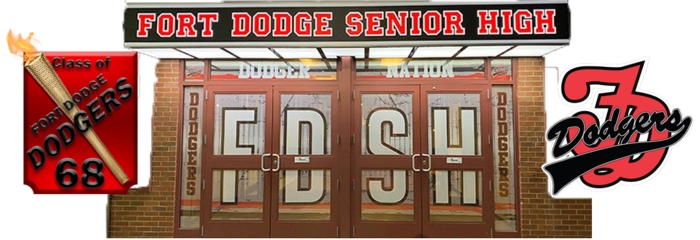
Fort Dodge Senior High History
|
In 1869, Fort Dodge had grown in population, so bonds were issued and a new twelve-room school was started at the corner of 2nd Avenue North and 10th Street. However, five months later on January 20, 1870, the school building burned to the ground. The school board used the insurance they collected and began a new building on the same location. This new building was ready for use in the fall of 1872. Until it was completed, classes were held in various places: churches, empty store rooms, etc. The new building was named for D. K. Lincoln, president of the school board and an outstanding citizen. The building was then on the edge of town, and people complained of having to send their children “way out on the prairie” to school. It was often referred to as the “School on the Prairie.” The Lincoln School housed all grades, with the high school on the third floor.
|
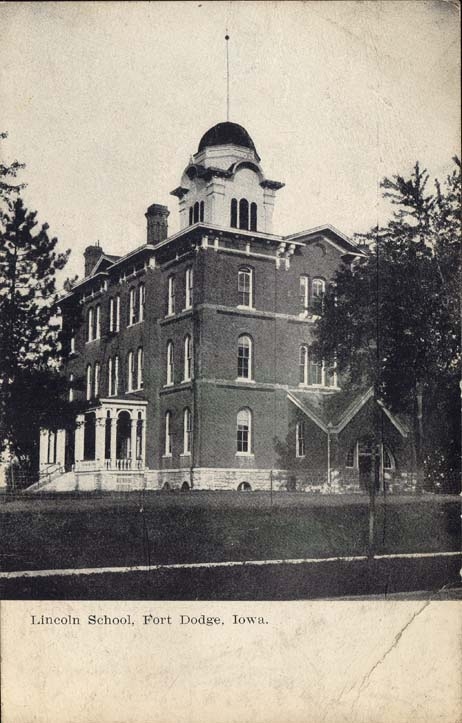
|
At the time, the Lincoln School was the only public school building in Fort Dodge. In 1872 the teaching staff consisted of ten women and one man. Early records do not speak of anyone as principal but refer simply to superintendent, or professor, as he was called. The high school became known for its progressive ideas. New supplies needed in the building were paid for by socials, programs, bazaars, suppers, etc., which students and teachers worked on as money-making projects. Lincoln School had about 350 pupils in attendance. The first high school graduating class was in 1875 – two young women and one young man made up the graduating class. In 1877 there was no graduating class. In 1878 seven students graduated and in 1879 only four. This was at a time when most Iowa towns only carried education through 8th grade. In 1875, there were very few high schools in Iowa, as many Iowans did not see high school as an educational necessity.
By 1897 the population of Fort Dodge had grown to 14,000. A new high school building was necessary. It was built on First Avenue North and Tenth Street. It was a three story building of yellow brick with many large windows and three outstanding entrances. Every foot of space in it was used. An unusually high basement had been built so that it could house the superintendent’s office, three recitation rooms, a bicycle room, a gymnasium, coal, boiler, and heating coil rooms.
|
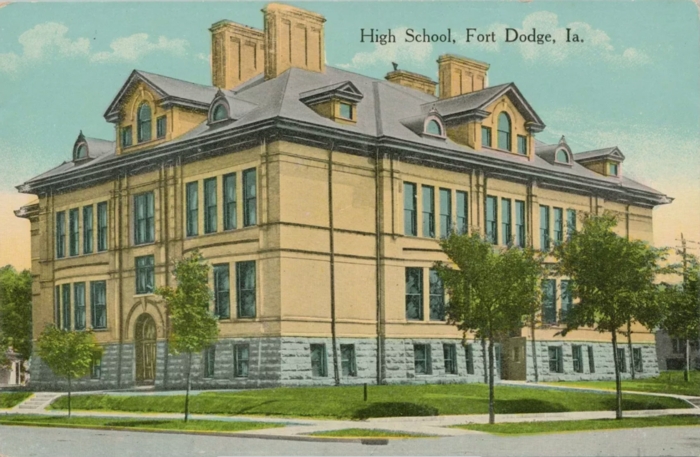
|
Most of the social activities held by high school groups in the early days were held in the homes. Football was introduced into the school in 1894. Interclass baseball was also played. In 1897 basketball for both boys and girls appeared. Those who played football in those days furnished their own equipment and did the coaching themselves.
The music department of the high school did not get underway until 1909. Then the first orchestra had six members. Athletics continued to grow in importance and around 1910 a coach was hired. An area for an athletic field was bought just east of Duncombe School.
In June of 1907. the high school building was damaged by fire. Because it was not totally destroyed, it was restored and ready for school in the fall. Due to an increased enrollment, several rooms were enlarged.
By 1918, the high school building on First Avenue North rapidly became outgrown. In 1919, petitions were started to ask the Board of Education to call an election to vote to issue bonds so a new lot might be bought and a new school be built and equipped. The vote for a new school carried easily.
Because Fort Dodge had spread out on both sides of the river and the distances from outlying districts were great, the question of a location for a new school was important. A consultant from Iowa City surveyed the city, found the center of population, and suggested a location. The Board then chose the site located at 1015 5th Ave North. The building was ready in September, 1922. It was built of dark red brick and is three stories high. Compared to the previous high school, it looked large and massive. (This building eventually became North Junior High after the new high school was built in 1958 and later renamed Phillips Middle School).
|
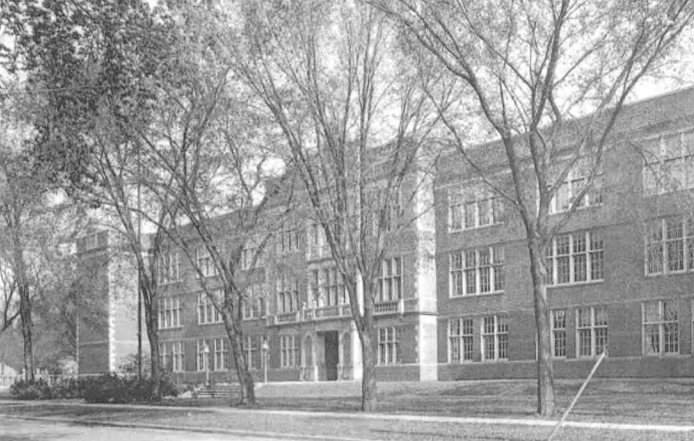
|
In 1921 the Fort Dodge School system added advanced courses beyond the regular four year high school program as the first step toward the establishment of a junior college, a new educational concept of the times. The college classes occupied the third floor of the new high school. The junior college was an extension of the Fort Dodge School System. The first teachers were high school teachers given additional assignments, a practice necessary because state funding did not extend beyond high school. The practice continued until the 1950s. Fort Dodge was the third school in the state to establish such a program.
Today, Fort Dodge Senior High School is the only public high school in Fort Dodge. The school is located in the north-central part of Fort Dodge between Martin Luther King Drive and North 25th Street. It is a part of the Fort Dodge Community School District.
Currently covering 248,300 square feet, Fort Dodge Senior High School was built in 1958, replacing the 1922 building. The swimming pool and additional physical education areas were completed in 1974. The last addition, the vocational area, was completed in 1979. Its open-floor design and industrial-style architecture is representative of the spacious neo-futuristic school designs that originated in California and other warmer climates during the middle to late 1950s. In 2008 and 2009, the kitchen, cafeteria, and surrounding sections of the interior received extensive renovations, part of a five-year plan to improve the student environment and to update the decor. The band, choir, and orchestra rooms were remodeled in 2009. Additional renovations are planned to classroom areas as well as athletic/fitness facilities. These updates are expected to cost more than $50 million and are planned to be completed in short phases over many years. |
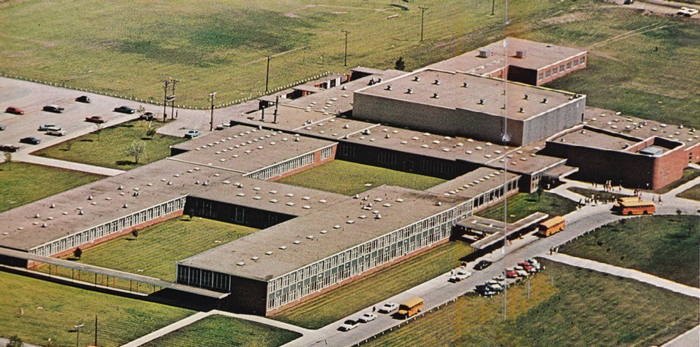
As We Roamed These Halls - Circa 1968
|
In 2018 the district established a 19,865-square-foot "Freshman Academy" to allow for easier transitions of 9th grade students to high school, with sixteen renovated classes and two classrooms placed in the library. Multiple athletic facilities were also added: a 200-seat new 9,141-square-foot auxiliary gymnasium with three basketball courts and three volleyball courts; a 6,678-square-foot wrestling room; as well as four locker rooms in a 11,016-square-foot area with two each for male and female students, were established that year. |
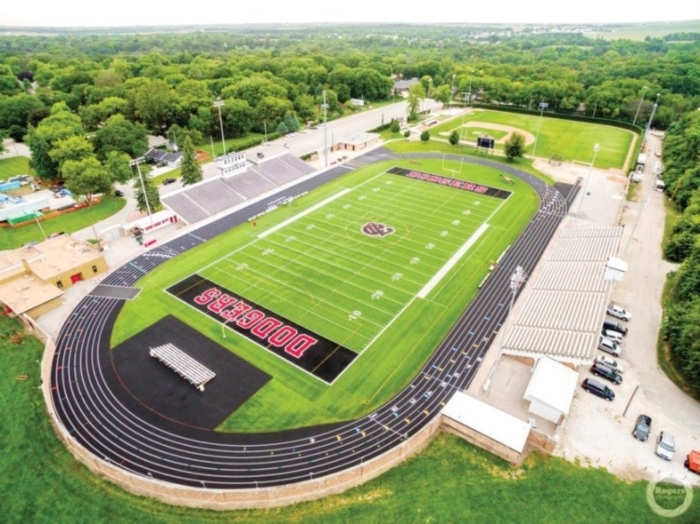
Photo courtesy ROGERS PHOTOGRAPHY
|
Brick-walled Dodger Stadium is home to Fort Dodge Senior High football, baseball, soccer and track teams. It remains one of the state's best athletic facilities, with permanent seating for 5,000 persons in the two concrete bleacher sections. The stadium is located in the north central section of the community on an 18-acre tract of land. Built in 1939–1940, Dodger Stadium is a product of President Franklin D. Roosevelt's plan to get depression-era America back to work. In 2008, the school district received just under $1,000,000 in pledges for private donations to renovate the stadium's locker rooms and grandstands and replace the natural grass playing surface with artificial turf. Work was completed on the turf in August 2008, with the inaugural game taking place on August 29, 2008. Renovation plans for the restroom and locker room areas have stalled due to lack of funding. Also included in the plan are new bleachers and a new scoreboard.
Fort Dodge Senior High School hosts the Iowa Girls' High School Athletic Union's state softball tournament and the Iowa High School Athletic Association's state cross country championships. The softball tournament is held at Harlan Rogers Sports Complex, while the cross country championships are located at Lakeside Golf Course at John F. Kennedy Park.
Composer Karl L. King wrote and conducted the majority of his music in Fort Dodge from 1920 to 1971, making marching band a popular activity for students and the community. The All-American Dodger Marching Band performs at all varsity home football games and competes in several regional field marching competitions throughout the year. The marching band performed during halftime of the 2010 Alamo Bowl in San Antonio, TX and the 2014 Outback Bowl in Tampa, Florida.
A Cappella Choir, a concert choir for mixed voices, was founded in 1931. The choir has traveled and performed throughout the United States. Today the choir program offers four curricular choirs, two extra-curricular choirs, independent study in composition, and music appreciation.
Every Spring, FDSH's choir students perform a musical. These productions have taken place every year since 1927, making it the longest consecutively running high school musical theatre tradition in the United States. The Spring of 2018 marked the 91st annual musical with the performance of Beauty and the Beast. Senior High's 90th Annual Musical, The Pajama Game, gained multiple recognitions from the Iowa High School Musical Theater Awards, including Outstanding Musical Production. In 1990, The A Cappella Choir performed the amateur debut of Stephen Sondheim's Into the Woods. |
Information provided by fortdodgehistory.com & WIKIPEDIA.
